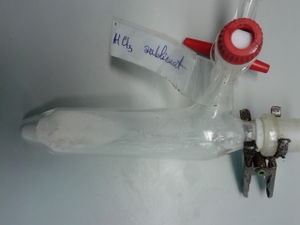Aluminium chloride
 Anhydrous AlCl3 purified via sublimation under vacuum
| |
| Names | |
|---|---|
| IUPAC name
Aluminium chloride
| |
| Other names
Aluminium(III) chloride
Aluminum trichloride | |
| Properties | |
| AlCl3 | |
| Molar mass | 133.341 g/mol (anhydrous) 241.432 g/mol (hexahydrate) |
| Appearance | White hygroscopic solid |
| Density | 2.48 g/cm3 (anhydrous) 2.398 g/cm3 (hexahydrate) |
| Melting point | 192.6 °C (378.7 °F; 465.8 K) (anhydrous) |
| Boiling point | 180 °C (356 °F; 453 K) |
| 43.9 g/100 ml (0 °C) 44.9 g/100 ml (10 °C) 45.8 g/100 ml (20 °C) 46.6 g/100 ml (30 °C) 47.3 g/100 ml (40 °C) 48.1 g/100 ml (60 °C) 48.6 g/100 ml (80 °C) 49.0 g/100 ml (100 °C) | |
| Solubility | Soluble in carbon tetrachloride, chloroform, diethyl ether, dioxane, ethanol, hydrogen chloride, methanol, THF Slightly soluble in benzene, toluene, xylene |
| Vapor pressure | 133.3 Pa (99 °C) 13.3 kPa (151 °C) |
| Thermochemistry | |
| Std molar
entropy (S |
109.3 J·mol-1·K-1 |
| Std enthalpy of
formation (ΔfH |
−704.2 kJ/mol |
| Hazards | |
| Safety data sheet | Sigma-Aldrich (anhydrous) Sigma-Aldrich (hexahydrate) |
| Lethal dose or concentration (LD, LC): | |
| LD50 (Median dose)
|
anhydrous 380 mg/kg (rat, oral) hexahydrate 3,311 mg/kg (rat, oral) |
| Related compounds | |
| Related compounds
|
Aluminium bromide Aluminium iodide Boron trichloride |
| Except where otherwise noted, data are given for materials in their standard state (at 25 °C [77 °F], 100 kPa). | |
| Infobox references | |
Aluminium chloride, or aluminium trichloride, is a chemical compound of aluminium and chlorine, with the formula AlCl3.
Contents
Properties
Chemical
Aluminium chloride has a high affinity for water. Hydrated aluminium chloride cannot be turned back anhydrous via heating heating as HCl is lost leaving aluminium hydroxide or alumina (aluminium oxide):
- Al(H2O)6Cl3 → Al(OH)3 + 3 HCl + 3 H2O
Physical
Aluminium chloride is a white hygroscopic salt. It melts at 192.4 °C (anhydrous form). The hydrated form, which is much less useful as a reagent, appears as grainy, oily beads which are often yellow due to even the smallest of iron impurities.
Availability
Aluminium chloride, both anhydrous and hydrated can be purchased from chemical suppliers.
Hydrated aluminium chloride is available as aqueous solution in may pool stores.
Preparation
Anhydrous aluminium chloride can be prepared by reacting aluminium metal with chlorine or hydrogen chloride gas in a water-free medium, at temperatures between 650 to 750 °C:
- 2 Al + 3 Cl2 → 2 AlCl3
- 2 Al + 6 HCl → 2 AlCl3 + 3 H2
The resulting AlCl3 vapors are condensed outside the reactor and then collected and stored in anhydrous conditions.
Aqueous AlCl3 can be prepared by reacting hydrochloric acid with aluminium metal. This reaction is very exothermic and the resulting hydrogen may ignite or explode if the reaction is done improperly.
Projects
- Friedel–Crafts reactions
- Organoaluminium compounds
- Make aluminium nitrate
Handling
Safety
Aluminium chloride is irritant to skin, eyes and respiratory system. It is a known neurotoxin.
Storage
Anhydrous AlCl3 must be stored in airtight sealed containers, to prevent it from hydrolyzing. Schlenk flasks are often used or long term storage, and ampouling may also be used for small amounts.
Hydrated aluminium chloride doesn't require special storage.
Disposal
Aluminium chloride will hydrolyze into aluminium hydroxide and hydrochloric acid. The acid is easy to neutralize and dispose of, but aluminium hydroxide is harmful to environment. Since is insoluble in water, it can easily be separated, purified and recovered.